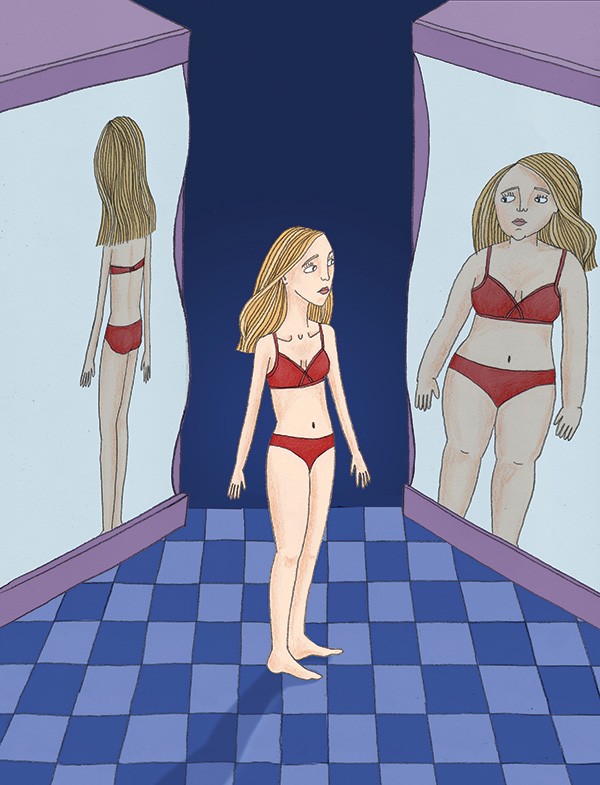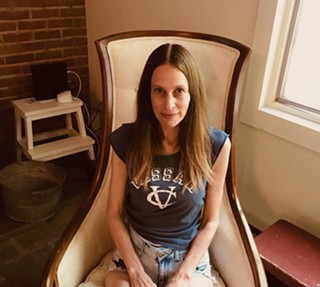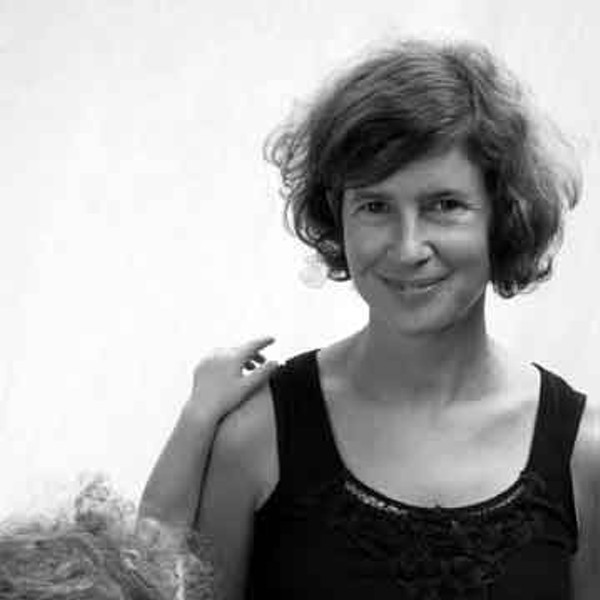Olivia Jansen's troubled relationship with food started when she was four or five. "In my family of origin there was this big secret, and I didn't find out about it until I was in my early teens," says Jansen (not her real name), of Greene County. "I had this feeling in my gut that there was something wrong with me that my family wasn't telling me. To suppress that, I ate a lot." As a kid she hated going to school: "I was tall, I was fat, and the teasing was unbelievable." Switching to an all-girls school helped, and once she found out her family's big secret, her eating normalized. Then Jansen hit college—and slid into anorexia and bulimia. "College food wasn't very good, but it was also the thrill of being on my own. I didn't have to listen to my mother saying 'You must eat something.' I always showed rebellion through food, either by eating too much or too little." Anorexia, a pattern of severe food restriction, came first for Jansen. Bulimia, or purging, kicked in when she became involved with men, after her first sexual experience. "From the time I was 19 until today there have been periods in my life where I've been fairly 'normal.' I'm eating, I'm not overexercising, not throwing up, not bingeing." But whenever a love relationship ended, the anorexia came back. "Then I'd get so thin that I'd end up bingeing because my body desperately needed food, and that led to purging," says Jansen, who is in treatment now for her eating disorders. "Hopefully this time around the cycle will end."
Blame it on a media fixated on rail-thin images of feminine beauty. Blame it on a love affair with perfection and control. Blame it on trauma, anxiety, or depression. Blame it on genetics or family dynamics. The story is unique for each individual, but all of these factors can contribute to the rise of an eating disorder. According to the National Eating Disorders Association (NEDA), about 20 million women and 10 million men in the US suffer from a clinically significant eating disorder at some point in their life. While teen and college-age girls are most affected, doctors are seeing more women in their 30s, 40s, and 50s with eating disorders. Anorexia nervosa has the highest mortality rate of any psychiatric disorder; physiological repercussions of anorexia and bulimia can include a risk of heart failure or cardiac arrest, osteoporosis, rupture of the esophagus, ulcers, and dental problems, to name a few. While eating disorders continue to rise—as they have done steadily each decade since the 1930s—the psychiatric community is finding more names to describe them. Orthorexia, a fixation on eating "healthy" to the point of self-harm—such as low-calorie salads for every meal—is a new disgnosis. And binge eating disorder, marked by recurring episodes of compulsive eating, was recently classified as a separate eating disorder. This is an insurance issue, says Kingston-based nutrition therapist Ilyse Simon, "but it also gives people a feeling of, yes, there's a name for this. That decreases the isolation and shame."
The Team Will See You Now
Simon is part of a unique breed of dieticians specializing in eating disorders, and some of her clients travel a distance to see her—Jansen is one of them. Yet Simon and other professionals will say that recovery isn't likely to happen with just one therapist or caregiver. The team approach offers the best chance to overcome an eating disorder. "It's not just me," says Simon. "It's also the therapist, the support group, the doctor. It's the yoga teacher, the partner or friend, the dentist. There are a lot of people on this team reinforcing behaviors and thought patterns." Ideally, a case manager will facilitate communication between caregivers. Some clients need support every day to build new habits that replace months or years of disordered eating. Simon might suggest that a client attend a support group one day, a therapy appointment or a Twelve Step meeting another day. (Eating Disorders Anonymous has a few dial-in phone meetings each week.) Simon also leads a writing group once or twice a year called "If My Body Could Talk," in which people with eating disorders are invited to write about and share their experiences. "A large amount of unstructured time doesn't go over very well," she says. "We like to ground the person every day with support from other people."
When the condition is acute, says psychotherapist and nurse practitioner Sil Reynolds, a more extreme intervention is necessary: round-the-clock care at a hospital or residential treatment center. Admission at a hospital-based program can be a life-saving step if someone is medically unstable. For most cases, Reynolds prefers a residential treatment center, which offers a homelike setting staffed with a range of professionals. "At these centers, women and girls, and men and boys, learn how to live recovery," says Reynolds, whose Stone Ridge-based practice specializes in eating disorders. "There's so much going on—individual therapy, group therapy before meals and after meals, art therapy, dance therapy, biofeedback, all kinds of good stuff." New York is one of the few states that does not have a residential treatment center—perhaps the closest is The Renfrew Center in Philadelphia. Such programs can cost $30,000 or more for a monthlong stay—and most insurance companies will pay only a fraction of this. "It's a travesty," says Reynolds of the insurance obstacle. "Only one in 10 people with eating disorders are getting the proper treatment, which is residential treatment." Perhaps the best local alternative is an intensive outpatient (IOP) clinic like the new LiveWell practice in Albany, which offers four hours of treatment per day, three days a week.
Starvation Can Be an Addiction
For someone entrenched in an eating disorder, learning to accept treatment—and to acknowledge that they have a problem in the first place—doesn't come easy. For Jansen, it was a sibling who woke her up to the fact that she was in trouble last year. "I'm very close with my sister, but she didn't want to have anything to do with me as I currently was, because I was so active in my eating disorder," says Jansen. "That was what started me thinking, maybe I do have a problem and need help." By then the eating disorder had become addictive; habits took hold and endorphins flooded the body like a drug. "In my own experience with anorexia, there's a certain point when you're below weight—you're not at the worst part but at the middle point—and I remember feeling constantly happy or on the verge of excitement. It was like I was high all the time, and I loved it." Eventually, Jansen's starving body demanded food. "I would plot on what supermarkets had my favorite foods to binge and purge on. The drive home would feel like it took forever; I couldn't get home fast enough to eat these things and then throw up. After throwing up, all the physical sensations—dizziness, weakness—were a kind of high. I assume it must be what a drug addict feels. I didn't have to think about the emotional stuff or any problems I might be having in my life."
Snapping out of behaviors like these doesn't happen overnight. That's why, in her nutrition therapy work, Simon initiates changes with baby steps. She once asked a client who had been bingeing every day for years, "Did you enjoy your last binge? How much ice cream did you eat until your tongue was frozen?" Simon gave the client homework: Go home tonight and binge with a food that you really enjoy. "This floored her. Years later she still talks about it as a changing moment in her life. She'd been bingeing for years, so I knew she wasn't going to stop that day. I just asked her to do it more mindfully." Today that client doesn't binge anymore—but getting there was a slow process of awareness, behavior modification, and compassion. Similarly, when Jansen was ready to feed her body again, Simon helped show what a healthy meal would look like for someone her height and age. "She broke it up into food groups and gave a list of foods that would fit into specific categories," says Jansen. "The calorie counting, the fat counting—all of that was out. With her, there were no rules, which was very freeing. As long as I was eating, the goal starting out was, okay, if you binge and purge, you can't go running. Or eat some protein afterwards. I wasn't horribly wrong for doing this or not doing that. She really met me where I was."
Learning to Love a Healthy Body
When an anorexic has starved her body for months or years and attempts to eat again and keep food down, it's no simple affair. In clinical terms, it's called the refeeding process. "Something as small as one nonfat Greek yogurt—I felt after eating one like I might as well have eaten 50," says Jansen. "I felt full and bloated and disgusting. It was really tough to sit with that and think, this is okay, my body really needs this. My body felt completely foreign to me and really scary." Over time, as she reached a normal weight, she had the challenge of accepting her new shape. "I missed seeing my bones," Jansen says. "My ribs, my hipbones, my collarbones—I loved my collarbones."
Reynolds's work taps deeply into the subject of body image; in her therapy sessions with clients, she'll attempt to challenge what she calls "the frightening new normal of body hatred" that prevails among women. Eating disorders take this skewed perspective to its ultimate expression. "What's really interesting is that the closer a person gets to their normal weight [after anorexia], the less they obsess about body image," says Reynolds. "When you're starving yourself, your thoughts get more and more distorted. Ironically, the more weight you gain, the less you obsess about your body, because you're getting the right nutrients and you're beginning to think straight." At that point, the therapy work that Reynolds does with her clients can get very deep and effective. Because even though an eating disorder is about food, it's not really about food. Emotional pain lies underneath, and exploring this terrain, says Reynolds, can be a spiritual journey.
Today Jansen is on her recovery path. She's in a healthy weight range, though she doesn't know what that weight is, exactly—she no longer owns a scale. At her lowest point she binged and purged five times a day; now it happens once a week, or once every two or three weeks. "I'm still in my dark night of the soul," she says, "but it's not pitch black. I might be able to go for a walk with my dog in the woods and be really present and happy in the moment. That, for me, is a big success."
RESOURCES
Eating Disorders Anonymous Eatingdisordersanonymous.org
Sil Reynolds, NP Stoneridgehealingarts.com
Ilyse Simon, RD, CDN Ilysesimonrd.com














